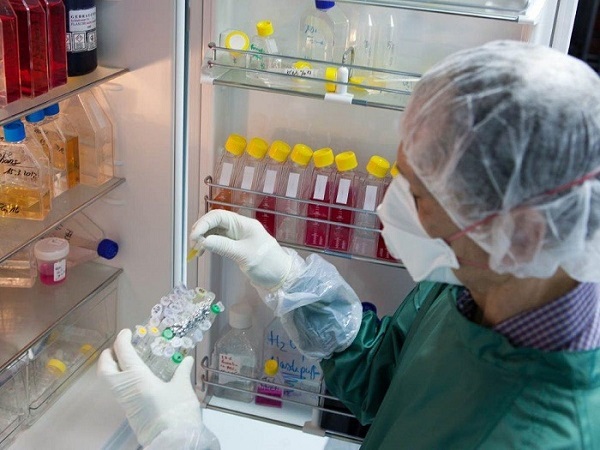Senegal can detect residues in food products through nuclear techniques
The laboratories received related method-validation protocols and training on analytical measurement uncertainty, proficiency testing and associated data analysis.

- Country:
- Senegal
Senegal’s authorities can now more quickly, independently and cost-effectively detect residues and contaminants in food products, benefiting the population’s health and the country’s food export competitiveness. The analysis is based on nuclear techniques.
With a four-year project ending this year, the IAEA, in partnership with the Food and Agriculture Organization of the United Nations (FAO), provided training to ten experts at four national laboratories to screen a wide range of residues and contaminants in foods that could cause health risks for consumers. The laboratories received related method-validation protocols and training on analytical measurement uncertainty, proficiency testing and associated data analysis.
“Before our advanced analytical capabilities were established, we were severely hampered and had to send scientists carrying several food samples abroad to laboratories in countries such as Morocco and France to test for food hazards. The outsourcing of analytical tests was cumbersome and time-consuming, but the situation has now reversed,” said Assiongbon Teko-Agbo, Head of LACOMEV, the Veterinary Drug Control Laboratory of the Inter-State School of Veterinary Sciences and Medicine of Dakar (EISMV).
Worldwide, veterinary medicines and pesticides are used in food production to control animal and plant diseases and pests. However, residues of these substances along with contaminants such as mycotoxins, biotoxins and toxic metals can present health risks to consumers. Testing ensures that products containing unacceptable levels of hazards are not allowed into the food supply chain.
Through the IAEA technical cooperation programme, state-of-the-art equipment to identify these hazards, including a radioreceptor assay and a liquid chromatography-tandem mass spectrometer, was delivered along with training on their use. The IAEA also provided laboratory information management systems and consumables.
The radioreceptor assay method is easy to use and provides accurate tests for more than 10 groups of veterinary antimicrobial and pesticide residues as well as mycotoxins in milk, meat, eggs, fish, honey, grains and animal feed. Availability of this capacity in Senegal is expected to boost consumer and market confidence and make the country’s exports of agricultural and food products more competitive. The volume of food products analysed for residues and contaminants has increased from 800 to 4000 tons per year since 2017, according to the Laboratory at the National Analysis and Control Laboratory (LANAC).
Besides LACOMEV and LANAC, two other laboratories took part in the project: the Food Technology Institute (ITA) laboratory and the Regional Center for Research on Ecotoxicology and Environmental Safety (Ceres Locustox).
Benefitting the fisheries and aquaculture sector
Thanks to the capabilities built during the IAEA/FAO project, LACOMEV was given responsibility for the implementation of a national residue monitoring programme for aquaculture products in 2017 – a growing subsector and a pillar of the Senegalese Accelerated Growth Strategy. The laboratory uses a combination of radioreceptor assay and isotopic chromatographic-spectrometric techniques (see The Science) to screen and confirm or exclude the presence of chemicals and related hazards in fish and aquaculture products.
The new testing capabilities have contributed to ensuring the reliability of Senegal’s fish product exports, with an average of over 300 million euros worth of annual export earnings between 2016 and 2019, according to the Ministry of Fisheries and Maritime Economy.
In parallel, thanks to the IAEA/FAO project, the ITA laboratory was accredited to ISO 17025 by the French accreditation committee (COFRAC) in aflatoxin analysis. This was an important outcome to protect the Senegalese population’s health while also supporting the country’s exports - aflatoxins being a major public health and trade concern globally, as they are potent cancer-causing agents.
Enhanced capacity across borders
In developing countries, the ability to establish laboratories capable of conducting routine food safety analysis and food safety surveillance programmes while meeting international standards is a key step towards increasing food safety and exports.
The enhanced capacity at the laboratories in Senegal also benefits other countries in the region. In the last two years, LACOMEV has trained more than 100 scientists from 15 French-speaking African countries and currently hosts up to 10 fellows and scientists each month. “This is incredibly vital for the African region, as it accelerates human resources development in nuclear science and applications in support of the sustainable development goals,” said Thuloane Tsehlo, the IAEA Programme Management Officer leading the project.
THE SCIENCE
Radio receptor assays are easy-to-perform and accurate tests that analyse more than 10 groups of veterinary antimicrobials, mycotoxins and pesticides. In these tests, binding agents, such as bacteria that selectively bind to the contaminants, are added to the sample, along with a version of the contaminant marked with a radioactive tracer. These include a radioactive isotope, typically tritium (3H) or carbon-14 (14C). If a sample is contaminated, the contaminant in the food sample is competing with the marked contaminant, so less of the latter is bound. If the sample contains no drug residues or other contaminants, the agent binds exclusively with the tracer-marked additive. This difference can be measured, and the amount of contaminant, if any, identified.
Liquid chromatography coupled with mass spectrometry: This analytical “fingerprinting” technique is used to detect and identify very low concentration levels of chemicals, in this case, food contaminants, and distinguish them from other material. High-performance liquid chromatography (HPLC) is used to separate each component in a mixture. The different components of the mixture react differently with the material in the chromatography tool, which provides the basis for the distinction. The mass spectrometer, at the same time, identifies and quantifies chemicals based on their molecular masses. While the two tools combined provide a more precise measurement than each one would do individually, the addition of stable isotopes as reference material improves the reliability of the technique.










